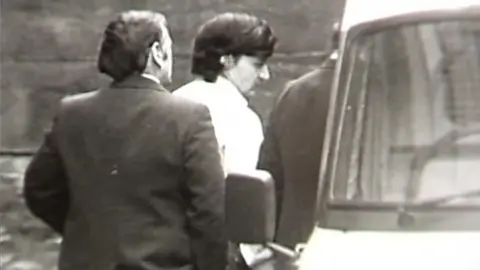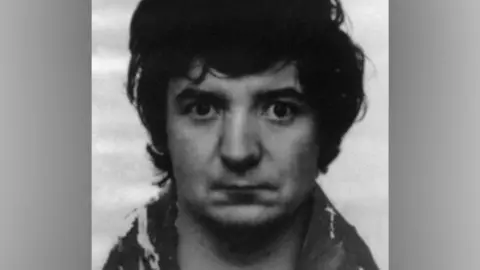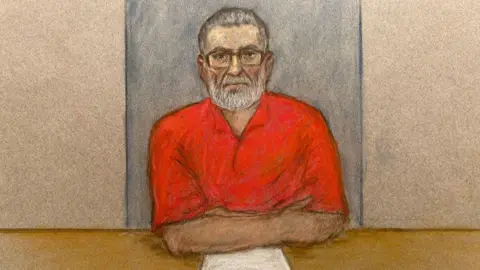Who is Peter Sullivan and why was he jailed?
 BBC
BBCPeter Sullivan spent more than 38 years in jail in what is believed to be the biggest miscarriage of justice in British history.
The murder of 21-year-old Diane Sindall in Birkenhead in 1986 sparked the biggest manhunt Merseyside had ever seen.
But Sullivan, now 68, and his defence team long insisted the police had got the wrong man.
The BBC's archives from the mid 1980s and court documents help piece together what happened before Sullivan was jailed for life for a crime someone else committed.
Who was Diane Sindall?

Ms Sindall was well-known in her hometown of Seacombe in Wirral.
Her family ran a well-known floristry business, and she could often be seen driving her blue van around, delivering flowers.
In 1986 Ms Sindall was trying to save money to get married the following year, so worked behind the bar at the Wellington pub in Bebington, five miles south of Seacombe.
She was working at the Wellington on 1 August 1986, the last night she was seen alive.
What happened on the night Diane Sindall was murdered?
Ms Sindall set off from the Wellington to drive home at about 23:45 BST.
After her van ran out of petrol in Birkenhead she started walking along the busy and well-lit main route of Borough Road.
The sequence of events that led to Ms Sindall's death was reconstructed by the BBC's Crimewatch a few weeks later.
A taxi driver told Crimewatch that he saw a man and a woman arguing at about 00:10 on Borough Road.
"The fellow put his hand out towards the girl. They appeared to know each other but they were definitely arguing", he said.
People reported hearing screams between 00:30 and 02:00 - the time when Ms Sindall is thought to have encountered the man who attacked her.
Her half-naked body was found in an alleyway off Borough Road by a dog walker the next morning.
She had a fractured skull, facial lacerations and bruising, mutilated breasts and lacerated genitals, according to court documents seen by the BBC.
It was thought Ms Sindall had remained alive for some time after the attack, but she died from a brain haemorrhage thought to have been caused by multiple blows to the head.
A pathologist who examined Ms Sindall's body later said in court her injuries were "the very worst" he had ever seen on a body "outside of a road traffic accident".
How did police try to catch Diane Sindall's killer?
 Merseyside Police
Merseyside PoliceMerseyside Police spoke to 3,000 people as part of its investigation.
The attack caused shock, revulsion and anxiety, especially among women and girls.
"Girls were afraid to be on the streets alone", said former Liverpool Echo journalist John Thompson, who covered the case at the time.
"Fathers, boyfriends, brothers and husbands would pick women up from work and tell them not to leave the premises until they were right outside the door," he said.
"There was real terror," he added, because Ms Sindall's murder was "different - it was horrific".
"[There was] someone was on the streets of Merseyside who was a real danger to women, who needed to be caught".
The attack led to the area's first Reclaim the Night march across the River Mersey. The movement had been set up in Leeds in 1977, during Yorkshire Ripper Peter Sutcliffe's killing spree, as a response to police advice that women should stay indoors.
"It was the sheer normality of it that was so scary, because any of us could have just run out of petrol and been walking along the road", said Josephine Wood from RASA Merseyside, a charity that supports victims of rape and sexual assault founded in the aftermath of Miss Sindall's death.
At one point, detectives were said to be considering interviewing every man in Birkenhead.
But for weeks they appeared to have no leads, and no clue about how Ms Sindall had ended up in the alleyway, because nobody saw the attack take place.
Why was Peter Sullivan jailed?
The day after Ms Sindall's murder some of her clothes were found burning in a small fire on nearby Bidston Hill, and a passing couple told police they saw a man, running out of bushes, whom they recognised as "Pete".
But they failed to pick him out of an identity parade.
More witnesses to the fire contacted the police after the Crimewatch reconstruction, and their descriptions of the man they saw prompted the police to go back to Sullivan.
He was arrested for murder on 23 September after he gave officers a number of "completely different" accounts of his movements.
The next day, court documents show Sullivan broke down in tears under questioning and "confessed" to the murder.
He withdrew the apparent confession later that day, but reinstated it soon afterwards.
Sullivan had not been given access to legal advice by that point. It had been withheld on the grounds that it would have caused a "hindrance to the enquiry".
When he was given access to a solicitor on 25 September, he retracted his confessions and told police he had made them up.
His trial in 1987 was told about his apparent confessions, as well as claims from dental experts that bite marks on Ms Sindall's body could be matched to Mr Sullivan's teeth.
On the night Sullivan was jailed for life for murder, BBC North West Tonight reported how he stood silently in the dock at Liverpool Crown Court, while his mother broke down and screamed, and his sister fainted and had to be revived.
After Sullivan was sentenced, Det Supt Tom Baxter told the BBC Sullivan "wasn't an excitable person", adding "he seemed to be a quiet sort of fellow - but what is the type of person that commit these murders?"
Mr Sullivan was then condemned to be known for the rest of his life by the names he had been given by some of the tabloid newspapers - "the Beast of Birkenhead" and "the Mersey Ripper".
 BBC/ Julia Quenzler
BBC/ Julia QuenzlerWho did kill Diane Sindall?
Ms Sindall's killer has not been identified.
An unsuccessful appeal hearing in 2019 heard various criticisms of the police investigation and the 1987 trial.
Last year it was announced new forensic testing of a semen sample from the scene had revealed a DNA profile which did not match Mr Sullivan - but officers have not been able to identify the person it does match.
In February, Merseyside Police said it had reopened its investigation into Ms Sindall's murder, and had sent letters to people identified in 1986 asking them to voluntarily submit DNA samples so they could be "eliminated" from their enquiries.
Psychologist Dr Harry Wood said his assessment of Sullivan had highlighted his "limited intellectual capacity" and "suggestibility", which he said should have led to concerns about his answers in interviews and his apparent confessions.
He also said that in the present day Mr Sullivan would have been accompanied by a solicitor in his interviews and probably an "appropriate adult" who would have the task of safeguarding the interests of a vulnerable person.
Expert dentist Prof Iain Pretty also criticised the claims made in the trial which linked bite marks to Mr Sullivan's teeth.
There is now renewed concern on Merseyside that a murderer has remained at large and unpunished for close to 40 years.
In Birkenhead, fresh flowers and small notes are still left at a small black granite memorial to her close to the scene of the attack on Borough Road.
It states Ms Sindall was murdered "because she was a woman".
Listen to the best of BBC Radio Manchester on Sounds and follow BBC Manchester on Facebook, X, and Instagram. You can also send story ideas via Whatsapp to 0808 100 2230.
